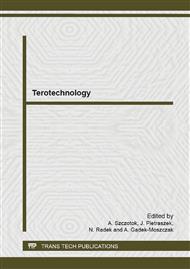[1]
R.A. Fisher, Statistical Methods for Research Workers, Oliver and Boyd Press, Edinburgh (1925).
Google Scholar
[2]
R.A. Fisher, The Arrangement of Field Experiments, J. Roy. Statist. Soc. 33 (1926) 503-513.
Google Scholar
[3]
R.A. Fisher, The Design of Experiments, Oliver and Boyd Press, Edinburgh (1935).
Google Scholar
[4]
F. Yates, Complex experiments, J. Roy. Statist. Soc. Suppl. 2 (1935) 181-247.
Google Scholar
[5]
R.L. Plackett, J.P. Burman, The design of optimum multifactorial experiments, Biometrika 33 (1946) 305-325.
DOI: 10.1093/biomet/33.4.305
Google Scholar
[6]
G.E.P. Box, K.B. Wilson, On the Experimental Attainment of Optimum Conditions, J. Roy. Stat. Soc. B 13 (1951) (1) 1-45.
Google Scholar
[7]
G. Elfving, Optimum Allocation in Linear Regression Theory, Ann. Math. Stat. 23 (1952) (2) 255-262.
DOI: 10.1214/aoms/1177729442
Google Scholar
[8]
J. Kiefer, J. Wolfowitz, Optimum Designs in Regression Problems, Ann. Math. Stat. 30 (1959) (2) 271-294.
DOI: 10.1214/aoms/1177706252
Google Scholar
[9]
V.V. Fedorov, Theory of Optimal Experiments, Elsevier, (1972).
Google Scholar
[10]
H. Chernoff, Sequential Analysis and Optimal Design, Harvard University, Cambridge, Massachusetts, (1972).
Google Scholar
[11]
J. McElroy, Taguchi - Japans Secret Weapon, Automot. Ind. 164 (1984) (8) 18.
Google Scholar
[12]
M.S. Phadke, Quality Engineering Using Robust Design, Prentice Hall International, Inc., London (1989).
Google Scholar
[13]
O. Kempthorne, K. Hinkelmann, Design and analysis of experiments. Vol. 1. Introduction to experimental design, John Wiley & Sons, Hoboken, NJ, USA (1994).
Google Scholar
[14]
O. Kempthorne, K. Hinkelmann, Design and analysis of experiments. Vol. 2. Advanced experimental design, John Wiley & Sons, Hoboken, NJ, USA (1994).
Google Scholar
[15]
K. Hinkelmann, Editor, Design and analysis of experiments. Vol. 3. Special Designs and Applications, John Wiley & Sons, Hoboken, NJ, USA (2012).
Google Scholar
[16]
ISO 3534-3: 2013, Statistics - Vocabulary and symbols - Part 3: Design of experiments, (2013).
Google Scholar
[17]
R.L. Mason, R.F. Gunst, J.L. Hess, Statistical Design and Analysis of Experiments, John Wiley & Sons, Hoboken (1989).
Google Scholar
[18]
S.S. Stevens, On the theory of scales of measurements, 103 (1946) 677-680.
Google Scholar
[19]
W. Grzegożek, J. Szczygieł, M. Król, An Attempt of an Employment of a Continuous Wavelet Transform for Evaluation of Temporary Comfort Disturbance, J. KONES 16 (2009) 165-172.
Google Scholar
[20]
J. Pietraszek, W. Grzegożek, J. Szczygieł, Forecasting of Subjective Comfort in Tram Using Ordinal Logistic Regression and Manifold Learning, 19 (2012) (2) 403-410.
DOI: 10.5604/12314005.1138238
Google Scholar
[21]
A. Agresti, Categorical Data Analysis, John Wiley & Sons, Hoboken (2002).
Google Scholar
[22]
J.M. Hilbe, Logistc Regression Models, CRC Press, Boca Raton (2009).
Google Scholar
[23]
D.W. Hosmer, S. Lemeshow, Applied Logistic Regression, John Wiley & Sons, Hoboken (2000).
Google Scholar
[24]
I.T. Jolliffe, Principal Component Analysis, Springer, New York (2002).
Google Scholar
[25]
E. Skrzypczak-Pietraszek, J. Pietraszek, Chemical profile and seasonal variation of phenolic acid content in bastard balm (Melittis melissophyllum L., Lamiaceae), J Pharmaceut Biomed 66 (2012) 154-161.
DOI: 10.1016/j.jpba.2012.03.037
Google Scholar
[26]
J. Pietraszek, Fuzzy Regression Compared to Classical Experimental Design in the Case of Flywheel Assembly, Lect Notes Artif Int 7267 (2012) 310-317.
DOI: 10.1007/978-3-642-29347-4_36
Google Scholar
[27]
J. Pietraszek, N. Radek, DoE-based model for tribology of laser textured surfaces of silicon carbide, in: T. Łodygowski, J. Rakowski, T. Garbowski and W. Sumelka, (Eds. ), CMM-2013 - Computer Methods in Mechanics, 27-31. 08. 2013, Poznań, Poland, Poznań University of Technology (2013).
Google Scholar
[28]
D.C. Montgomery, Design and Analysis of Experiments, John Wiley & Sons, Inc., Hoboken (2008).
Google Scholar
[29]
J. Pietraszek, M. Kołomycki, E. Kocyłowska, The impact of CUDA technology on the efficiency of Blender renderer program, Czasopismo Techniczne 110 (2013) (1-M) 317-324.
Google Scholar
[30]
P. Osocha, P. Duda, B. Weglowski, Determining temperature and stress changes in thick-walled elements of steam lines, Inz Chem Procesowa 25 (2004) (4) 2249-2256.
Google Scholar
[31]
T. Styrylska, J. Pietraszek, Numerical Modeling of Non-Steady-State Temperature-Fields with Supplementary Data, Z Angew Math Mech 72 (1992) (6) T537-T539.
Google Scholar
[32]
J. Pietraszek, A. Gądek-Moszczak, N. Radek, The Estimation of Accuracy for the Neural Network Approximation in the Case of Sintered Metal Properties, in: A. Badica, (Ed. ), Recent Developments in Computational Collective Intelligence., Studies in Computational Intelligence 513, Springer (2014).
DOI: 10.1007/978-3-319-01787-7_12
Google Scholar
[33]
A. Gadek, S. Kuciel, L. Wojnar, W. Dziadur, Application of computer-aided analysis of an image for assessment of reinforced polymers structures, Polimery-W 51 (2006) (3) 206-211.
DOI: 10.14314/polimery.2006.206
Google Scholar
[34]
A. Gadek-Moszczak, L. Wojnar, Objective, Quantitative and Automatic X-Ray Image. Analysis of the Bone Regenerate in the Ilizarov Method, (2009) 453-458.
Google Scholar
[35]
A. Gadek-Moszczak, S. Zmudka, Description of 3D microstructure of the composites with polypropylene (PP) matrix and Tuf particles fillers, Solid State Phenom. 197 (2013) 186-191.
DOI: 10.4028/www.scientific.net/ssp.197.186
Google Scholar
[36]
A. Szczotok, R. Przeliorz, Phase transformations in CMSX-4 nickel-base superalloy, IOP Conf. Ser. -Mat. Sci. 35 (2012).
DOI: 10.1088/1757-899x/35/1/012005
Google Scholar
[37]
A. Szczotok, M. Sozanska, A Comparison of Grain Quantitative Evaluation Performed with Standard Method of Imaging with Light Microscopy and EBSD Analysis, Prakt Metallogr-Pr M 46 (2009) (9) 454-468.
DOI: 10.3139/147.110043
Google Scholar


